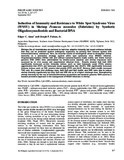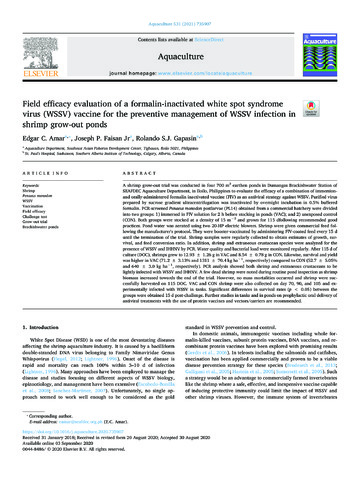Sandfish (Holothuria scabra) as potential reservoir of white spot syndrome virus (WSSV) when co-cultured with black tiger prawn (Penaeus monodon)

Associated URL
eafpbulletin.scholasticahq.comPetsa
2024-03-08May-akda
Page views
54Metadata
Ipakita ang buong tala ng itemCited times in Scopus
Share
Abstract
Since the first occurrence of White Spot Disease (WSD) in 1992, it is still listed as one of the crustacean diseases by the World Organisation for Animal Health in 2022. Horizontal transmission in co-culture systems is one of the usual modes in the spread of the disease. WSD outbreak was recorded during the experimental run of the co-culture of black tiger prawn (Penaeus monodon) and sandfish (Holothuria scabra) in the grow-out phase. In this study, artificial infection through two cohabitation experiments were conducted to determine if H. scabra is a potential non-crustacean vector or reservoir of WSSV. Samples were checked using one-step and nested PCR for increased readout sensitivity of virus infection to investigate the horizontal transmission between prawn and sandfish. During the first cohabitation (5 days) where WSSV (+) prawn were cohabited with WSSV (-) sandfish, 100% of the prawn were one-step PCR positive for WSSV while 100% of the sandfish were nested PCR positive. Subsequently, WSSV (+) sandfish from the first cohabitation were transferred to another tank to be cohabited with WSSV (-) prawn. Sampling of both prawn and sandfish was done every 6 days post-infection (dpi). At 6 to 18 dpi, prawn and sandfish were nested PCR positive. At 25 dpi, there were no prawns left due to mortality and 1 of the 3 remaining sandfish was nested PCR positive. Based on the results, it elucidates the ability of sandfish to bioaccumulate the viral particles when cohabited with WSSV (+) prawn. Results suggest that WSSV is viable in the sandfish confirming its potential as a vector or reservoir due to the consistent nested PCR positive results of the prawn during the second cohabitation. Hence, it can be inferred that sandfish can be a potential non-crustacean vector or reservoir of WSSV for a limited period of time.
Suggested Citation
de la Peña, L. D., Caber, D. B., Villacastin, A. J. B., Cabillon, N. A. R., Arboleda, J. I., Castellano, J. L. A., Nava, J. K. P. T., & Watanabe, S. (2024). Sandfish (Holothuria scabra) as potential reservoir of white spot syndrome virus (WSSV) when co-cultured with black tiger prawn (Penaeus monodon). Bulletin of the European Association of Fish Pathologists. https://doi.org/10.48045/001c.94283
Paksa
Taxonomic term
Mga koleksyon
- AQD Journal Articles [1221]
Maliban kung saan nakasaad, ang lisensya ng item na ito ay inilalarawan bilangAttribution 4.0 International
Related items
Showing items related by title, author, creator and subject.
-
White spot syndrome virus (WSSV) risk factors associated with shrimp farming practices in polyculture and monoculture farms in the Philippines
Tendencia, Eleonor; Bosma, Roel H.; Verreth, Johan A. J. (Elsevier, 2011)White spot sydrome virus (WSSV) is one of the most important viral disease of shrimp. Several studies to control the disease have been done. Tank experiments identified WSSV risk factors related to the physico chemical ... -
Induction of immunity and resistance to white spot syndrome virus (WSSV) in shrimp Penaeus monodon (Fabricius) by synthetic oligodeoxynucleotide and bacterial DNA
Amar, Edgar C.; Faisan, Joseph P., Jr. (University of the Philippines Los Baños, 2012)Shrimps like all invertebrates are believed to lack true adaptive immunity but recent evidence indicate that they can be protected against pathogenic organisms by priming their immune system with immunostimulatory substances. ... -
Field efficacy evaluation of a formalin-inactivated white spot syndrome virus (WSSV) vaccine for the preventive management of WSSV infection in shrimp grow-out ponds
Amar, Edgar; Faisan, Joseph P., Jr.; Gapasin, Rolando S. J. (Elsevier, 2021)A shrimp grow-out trial was conducted in four 700 m2 earthen ponds in Dumangas Brackishwater Station of SEAFDEC Aquaculture Department, in Iloilo, Philippines to evaluate the efficacy of a combination of immersion- ...







